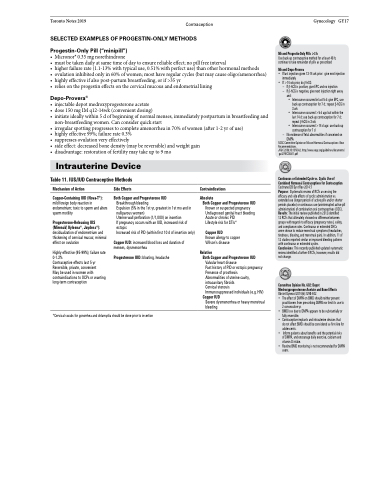Page 503 - TNFlipTest
P. 503
Toronto Notes 2019 Contraception SELECTED EXAMPLES OF PROGESTIN-ONLY METHODS
Progestin-Only Pill (“minipill”)
• Micronor®0.35mgnorethindrone
• mustbetakendailyatsametimeofdaytoensurereliableeffect;nopillfreeinterval
• higherfailurerate(1.1-13%withtypicaluse,0.51%withperfectuse)thanotherhormonalmethods
• ovulationinhibitedonlyin60%ofwomen;mosthaveregularcycles(butmaycauseoligo/amenorrhea) • highlyeffectiveifalsopost-partumbreastfeeding,orif>35yr
• reliesontheprogestineffectsonthecervicalmucousandendometriallining
Depo-Provera®
• injectabledepotmedroxyprogesteroneacetate
• dose150mgIMq12-14wk(convenientdosing)
• initiate ideally within 5 d of beginning of normal menses, immediately postpartum in breastfeeding and
non-breastfeeding women. Can consider quick start
• irregularspottingprogressestocompleteamenorrheain70%ofwomen(after1-2yrofuse) • highly effective 99%; failure rate 0.3%
• suppressesovulationveryeffectively
• side effect: decreased bone density (may be reversible) and weight gain
• disadvantage:restorationoffertilitymaytakeupto9mo
Gynecology GY17
Missed Progestin-Only Pills >3 h
Use back-up contraceptive method for at least 48 h; continue to take remainder of pills as prescribed
Missed Depo-Provera
• Iflastinjectiongiven13-14wkprior: givenextinjection immediately
• If>14wkprior,doβ-hCG
– Ifβ-hCGispositive,giveEPCandnoinjection
– Ifβ-hCGisnegative,givenextinjectionrightaway
and:
• Intercourseoccurredinlast5d:giveEPC,use
back-up contraception for 7 d ; repeat β-hCG in
3 wk
• Intercourseoccurred>5dagobutwithinthe
last 14 d: use back-up contraception for 7 d;
repeat β-hCG in 3 wk
• Intercourseoccurred>14dago:useback-up
contraception for 7 d
– No evidence of fetal abnormalities if conceived on
DMPA
SOGC Committee Opinion on Missed Hormonal Contraceptives: New Recommendations.
JOGC 2008;30:1050-62. http://www.sogc.org/guidelines/documents/ gui219ECO0811.pdf
Continuous or Extended Cycle vs. Cyclic Use of Combined Hormonal Contraceptives for Contraception Cochrane DB Syst Rev 2014:7
Purpose: SystematicreviewofRCTsassessingthe efficacy and side effects of cyclic administration vs. extended use (longer periods of active pills and/or shorter periods placebo) or continuous use (uninterrupted active pill administration) of combination oral contraceptives (COC). Results: The initial review published in 2012 identified
12 RCTs that ultimately showed no difference between groups with regards to efficacy (pregnancy rates), safety, and compliance rates. Continuous or extended CHCs
were shown to reduce menstrual symptoms (headaches, tiredness, bloating, and menstrual pain). In addition, 11 of 12 studies reported similar or improved bleeding patterns with continuous or extended cycles.
Conclusions: This recently published updated systematic review identified a further 4 RCTs, however, results did
not change.
Committee Opinion No. 602: Depot Medroxyprogresterone Acetate and Bone Effects Obstet Gynecol 2014(6):1298-402
• TheeffectofDMPAonBMDshouldneitherprevent
practitioners from prescribing DMPA nor limit its use to
2 consecutive yr.
• BMDlossduetoDMPAappearstobesubstantiallyor
fully reversible.
• Contraceptiveimplantsandintrauterinedevicesthat
do not affect BMD should be considered as first-line for
adolescents.
• Inform patients about benefits and the potential risks
of DMPA, and encourage daily exercise, calcium and
vitamin D intake.
• RoutineBMDmonitoringisnotrecommendedforDMPA
users.
Intrauterine Device
Table 11. IUS/IUD Contraceptive Methods
Mechanism of Action
Copper-Containing IUD (Nova-T®):
mild foreign body reaction in endometrium; toxic to sperm and alters sperm motility
Progesterone-Releasing IUS (MirenaV, Kyleena®, Jaydess®): decidualization of endometrium and thickening of cervical mucus; minimal effect on ovulation
Highly effective (95-99%); failure rate 0-1.2%
Contraceptive effects last 5 yr Reversible, private, convenient
May be used in women with contraindications to OCPs or wanting long-term contraception
Side Effects
Both Copper and Progesterone IUD
Breakthrough bleeding
Expulsion (5% in the 1st yr, greatest in 1st mo and in nulliparous women)
Uterine wall perforation (1/1,000) on insertion
If pregnancy occurs with an IUD, increased risk of ectopic
Increased risk of PID (within first 10 d of insertion only)
Copper IUD: increased blood loss and duration of menses, dysmenorrhea
Progesterone IUD: bloating, headache
Contraindications
Absolute
Both Copper and Progesterone IUD
Known or suspected pregnancy Undiagnosed genital tract bleeding Acute or chronic PID
Lifestyle risk for STIs*
Copper IUD
Known allergy to copper Wilson’s disease
Relative
Both Copper and Progesterone IUD
Valvular heart disease
Past history of PID or ectopic pregnancy Presence of prosthesis
Abnormalities of uterine cavity, intracavitary fibroids
Cervical stenosis
Immunosuppressed individuals (e.g. HIV)
Copper IUD
Severe dysmenorrhea or heavy menstrual bleeding
*Cervical swabs for gonorrhea and chlamydia should be done prior to insertion


